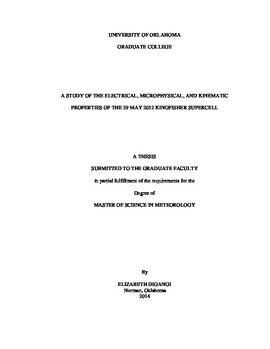| dc.contributor.advisor | MacGorman, Donald R. | |
| dc.contributor.author | DiGangi, Elizabeth | |
| dc.date.accessioned | 2015-04-07T21:16:12Z | |
| dc.date.available | 2015-04-07T21:16:12Z | |
| dc.date.issued | 2014 | |
| dc.identifier.uri | https://hdl.handle.net/11244/14246 | |
| dc.description.abstract | A supercell thunderstorm formed as part of a cluster of severe storms near Kingfisher, OK on 29 May 2012 during the Deep Convective Clouds & Chemistry (DC3) experiment. This storm produced 5” hail, an EF-1 tornado, and copious lightning over the course of a few hours. For part of the storm's lifetime, observations were obtained from mobile polarimetric radars and a balloon-borne electric field meter (EFM) and particle imager, while aircraft sampled the chemistry of the inflow and anvil. In addition, the storm was within the domain of the 3-dimensional Oklahoma Lightning Mapping Array (LMA), and the National Weather Service’s KTLX WSR-88D radar. | en_US |
| dc.description.abstract | This study focuses on a one-hour interval during which multi-Doppler coverage was available, and a balloon carrying an electric field meter (EFM), radiosonde, and particle imager flew through the storm. Data from KTLX are used to supplement mobile radar data. Flash rates, mapped very high frequency (VHF) source densities, and charge analyses are examined to give an overview of the storm’s electrical nature and evolution during that period. The charge inferred from lightning is compared to the charge inferred from EFM measurements to test how well the lightning-inferred charge analysis can be expanded to the whole storm. | |
| dc.description.abstract | After an initial overview of the storm’s lifetime and the environment in which the storm formed, the evolution of the flash size distribution as it relates to the kinematics and microphysics of the storm is examined at three analysis times spanning the approximately 40 minute period during which triple-Doppler data were acquired. Flash rates increased rapidly during this time. Lightning flash density, the horizontal areas (i.e., footprints) of flashes, VHF source density, and the locations of flash initiations are then compared to storm microphysics and kinematics as observed by radar and retrieved by a diabatic Lagrangian analysis of the synthesized three- dimensional winds and reflectivity. The inferred charge structure of the storm and its evolution are also compared to these flash parameters and to the storm’s microphysics and kinematics. When the storm matured, flashes in an around the updraft were typically small. Flash sizes tended to increase as distance from the updraft increased; as the storm strengthened, the overall size of flashes in the storm decreased. | |
| dc.description.abstract | Lightning flashes in the anvil, particularly those flashes that occurred several tens of kilometers from regions of deep convection, are also analyzed relative to radar reflectivity, ground strike points (provided by the National Lightning Detection Network), and inferred charge structure, to test hypotheses concerning how the flashes were initiated and why they propagated along certain paths. A region of convection strong enough to initiate lightning developed in the anvil during the analysis time and eventually propagated beyond the anvil. Its formation was consistent with being produced by evaporating virga falling from the anvil, as has been suggested previously. | |
| dc.language | en_US | en_US |
| dc.subject | Meteorology | en_US |
| dc.subject | Tornadoes | en_US |
| dc.subject | Radar | en_US |
| dc.title | A Study Of The Electrical, Microphysical, And Kinematic Properties Of The 29 May 2012 Kingfisher Supercell | en_US |
| dc.contributor.committeeMember | Biggerstaff, Michael | |
| dc.contributor.committeeMember | Ziegler, Conrad | |
| dc.contributor.committeeMember | Shapiro, Alan | |
| dc.contributor.committeeMember | Postawko, Susan | |
| dc.date.manuscript | 2014 | |
| dc.thesis.degree | MS | en_US |
| ou.group | College of Atmospheric & Geographic Sciences::School of Meteorology | en_US |
